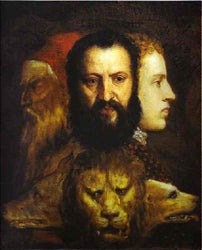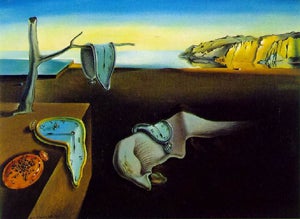From the beginning, artists have used images to symbolize their world, to record past events, and to imaginatively project themselves into future. The ability to simultaneously reflect on the past, dwell in the present, and speculate or anticipate future conditions is a special trait of human beings. Artists possess the added gift of finding visual expression for this kind of imaginative "time travel." Artist-hunters depicted game animals on the walls of the the Caves of Lascaux in what is now Southern France some 15,000 years ago.
...On the right
wall, the focal point of the composition, made up of a herd of small
horses, is a large black cow whose Some believe that early man, by making a picture in anticipation of the successful hunt, was projecting imaginatively into the future and seeking to capture the spirit of the animal. Thus, it is possible that these early cave paintings represent, with striking detail, past, present, and future events. The Renaissance Venetian painter, Titian, painted three heads alluding to the three ages of man: youth, maturity and old age. This series of portraits, painted when Titian was nearly eighty years old, could be said to be a metaphor for "a life lived." The left head resembles Titian himself in old age, the bearded central man has been thought to represent his son Orazio, and the youth may depict his cousin and heir, Marco Vecellio (born 1545). This "Janus head" seems to really be a portrait of one individual at different stages in their life. Titian. Allegory
of Time Governed by Prudence. c.1565. A very different approach to symbolizing the nature of time is taken by Salvador Dali in his famous work, The Persistence of Memory. Here the precision and reliability of time is called into question. There are multiple interpretations of the work: some critics feel the work reflects Dali's interest in Freud's theories of the unconscious; others suggest that the artist drew his conception of time and space from Einstein's theory of relativity. His "soft watches" may illustrate the difficulty of measuring such elusive targets as human memory, sexuality, and a universe defined by "relativity." Salvador Dali, The Persistence of Memory, 1931 http://www.salvadordali-prints.com/meanings.html
|














